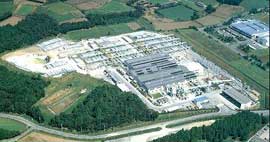Learn About Japan > Work and Workplaces in Japan > Workplaces > The Changing Income of Farm Households

|

Workplaces
- The Work Group
- Office Arrangements
- Office Ladies (OL)
- Enterprise Unions in Japan
- Enterprise Union Cooperation
- Strikes Japanese-Style
- Sexual Harassment
- Separate Surnames for Married Couples
- “Mighty” Women: Police and the Military Self Defense Force
- Ama (Female Diver)
- Who Farms in Japanese Farm Households?
- San-Chan Nōgyō
- The Changing Income of Farm Households
|

Factories built in rural areas provide employment for farm families.
Photo from Kyuatsu.co.jp.
The Changing Income of Farm Households
Farm households in Japan today receive less than 13 percent of their total income from farming activites. In 1975 the figure was 28.9 percent, but it dropped sharply during the 1980s. During this same time the disposable income (all income minus taxes) has nearly doubled. While living expenses have also doubled, the smaller farm housholds today have 50 percent more surplus income, and twice as much disposable income per person as they did in 1975. Farm households today enjoy much the same standard of living as urban dwellers. They have the same consumer goods in their homes, and are well-served by national transportation networks and communication services.
Since the 1980s, manufacturing companies have been moving some of their production facilities to rural areas, where wages and land prices are low. Nearby factory jobs allow farm families to remain in their rural homes but earn more cash wages.
|
Special Terms:
farm household
|
living expenses
|
surplus income
|
transportation network
|
| Download Podcast in
English
| Japanese
|
|
Document |
Audio-Video |
Chart |
Picture |
Map
|
|

